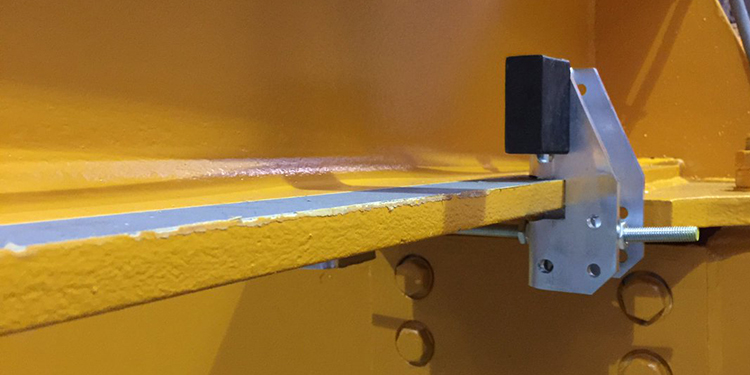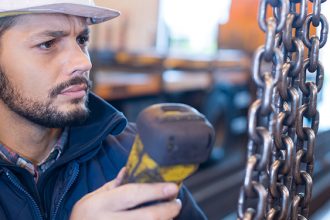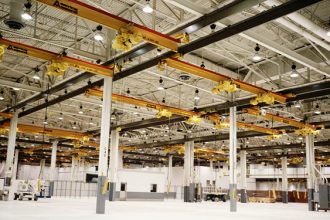End Stops: Best Practices For Specifying And Using In Overhead Handling Applications

End stops mark the end of a rail in an overhead crane or monorail system. Located at the termination point of the running surface for bridge and trolley travel, these fixed devices provide a physical barrier that fully engages the trolley or bridge bumper. They serve as a safety measure by preventing the load carrying device from traveling off the end of the rail. This reduces the risk of an accident or injury caused by the overhead load and its carrier falling off the end of a rail or track.
The Occupational Safety and Health Administration’s standard OSHA 1910.179(a)(57) defines an end stop as “a device to limit the travel of a trolley or crane bridge. This device is attached to a fixed structure and normally does not have energy absorbing ability.” Their use is covered by the Crane Manufacturers Association of America’s CMAA Specification 70, section 4.15: which states:
4.15.1. Runway stops limiting the bridge travel are normally designed and provided by the owner or specifier.
4.15.2. Stops are located at the limits of the trolley and bridge travel and shall engage the full surface of the bumper.
4.15.3. Stops engaging the tread of the wheel are not recommended.
Additionally, the patented track and enclosed track standards published by the Monorail Manufacturers Association (MMA) include sections on end stops.
- ANSI MH27.1 Patented Track Underhung Cranes and Monorail Systems, section 6(g) notes: “Stops shall be provided at the ends of the carrier and crane travel. Stops or forks shall be provided at open ends of tracks; such as interlocking cranes, track openers and track switches. Stops shall be provided to resist impact forces of a fully loaded carrier or crane traveling at a normal walking speed or at 50% of the rated full load speed, if the carrier or crane is motor driven.
- ANSI MH27.2 Enclosed Track Underhung Cranes and Monorail Systems, section 6(e) states: “Stops shall be provided at the ends of the trolley (carrier) and crane travel. Stops or forks shall be provided at open ends of tracks, such as: interlocking cranes, track openers and track switches. Stops shall be provided to resist impact forces of a fully loaded trolley (carrier) or crane traveling at a normal walking speed or at 50% of the rated full load speed, if the trolley (carrier) or crane is motor driven.”
Notably, end stops are not the same as end caps. End caps are used to close off the open end of a rail; end stops are usually placed at the farthest point that a bridge or trolley can travel (which may be several inches or more away from the end of the rail). Additionally, end stops can be used to segregate individual cranes and trolleys along different sections of the same rail, preventing a collision and restricting their movement to a specific work area within a facility.
There are a variety of best practices that should be followed when utilizing end stops on overhead handling equipment. These include:
- Train all overhead equipment operators to not operate the crane or trolley near the end stops; this is typically not necessary.
- End stops are not to be relied upon to stop the travel of a trolley or bridge.
- Educate operators about the potential damage and/or equipment failure that can happen if the trolley or bridge runs full speed into the end stop.
- The overhead system’s owner is responsible for ensuring that the end stops are designed correctly and are of sufficient strength to prevent the bridge or trolley from traveling off the end of the rail.
- End stops should be bolted or welded into place to a substantial member that will accommodate forces or loadings.
- Only the bumper of the trolley or bridge should come into contact with an end stop, not the wheels.
- Limit switches engineered to cut the power to the drive motor of the trolley or bridge may be required to prevent contact with the end stops.
Seeking more information about how to safely implement and use overhead lifting technologies? The three members of the Overhead Alliance — the Crane Manufacturers Association of America (CMAA), Hoist Manufacturers Institute (HMI) and the Monorail Manufacturers Association (MMA) — each offer in-depth resources, standards, specifications, and safety checklists specific to that type of equipment. Additionally, the three recently gained ambassador status with OSHA’s Crane, Hoist and Monorail Alliance (CHM), and will promote cooperative programs with the federal agency, raising awareness of OSHA’s initiatives, outreach, communication, training and education, and also providing information, guidance and access to training resources that help protect the health and safety of workers using hoists, cranes and monorails.



